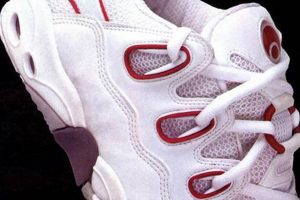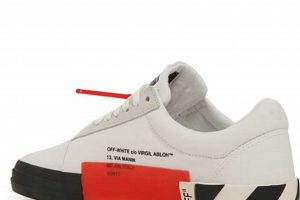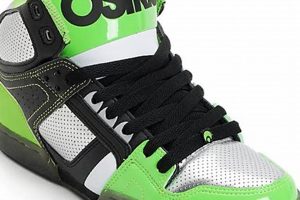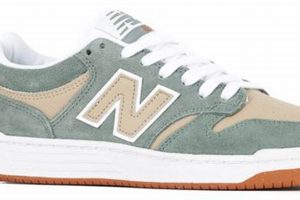Footwear designed for skateboarding, produced by Globe International, integrates features catered to the specific demands of the sport. These articles of apparel provide support, cushioning, and grip essential for performing tricks and navigating skate parks or street environments.
Such specialized footwear contributes to enhanced performance, safety, and durability compared to standard athletic shoes. The brand’s products often incorporate technologies designed to withstand abrasion from griptape and impacts from landings, reflecting a history rooted in action sports and youth culture.
The following sections will delve into construction materials, design variations, technological innovations, and relevant considerations for selecting appropriate skate-specific footwear from this manufacturer.
Optimizing Performance and Longevity
The subsequent guidelines aim to maximize the utility and lifespan of skateboarding-specific footwear. Adherence to these points will contribute to improved performance, safety, and cost-effectiveness.
Tip 1: Select the Appropriate Size: Ensure a snug, but not constricting, fit to maintain board feel and prevent slippage. Improper sizing can lead to discomfort and reduced control.
Tip 2: Inspect Stitching and Seam Integrity: Regularly examine the shoe’s construction, particularly around the ollie area and sole attachment. Early detection of wear allows for timely repairs, extending lifespan.
Tip 3: Utilize Shoe Goo or Similar Adhesives: Apply adhesive to areas prone to abrasion, such as the toe cap and side panels, to reinforce the material and delay the onset of wear.
Tip 4: Rotate Footwear Regularly: Alternate between multiple pairs to allow materials to decompress and recover, reducing overall wear and tear on any single pair.
Tip 5: Clean Footwear Periodically: Remove dirt and debris from the outer surface to prevent premature degradation of materials. Use appropriate cleaning agents based on the material composition.
Tip 6: Employ Additional Insoles: Replace the factory insoles with aftermarket options that provide enhanced cushioning and arch support, improving comfort and reducing impact stress.
Tip 7: Consider Suede or Leather Uppers: These materials offer superior durability compared to canvas, especially in high-wear areas. Proper maintenance will further extend their lifespan.
Implementing these recommendations will contribute to extended product lifespan, enhanced comfort, and improved performance during skateboarding activities.
The following concluding remarks will summarize the primary advantages of selecting purpose-built skateboarding footwear.
1. Durability
The longevity of a “globe skate shoe” is inextricably linked to its inherent durability. Skateboarding, by its nature, subjects footwear to extreme abrasion from griptape, repeated impacts from landings, and general wear and tear from environmental factors. Consequently, the capacity of a skate shoe to withstand these forces directly determines its usable lifespan and overall value proposition.
The brand integrates specific design elements to enhance product robustness. Reinforced stitching in high-stress areas, such as the ollie zone and around the sole, prevents premature separation of components. The utilization of durable materials, including suede and leather uppers, offers greater resistance to abrasion compared to canvas alternatives. Furthermore, the incorporation of thicker rubber compounds in the outsole construction provides enhanced grip and abrasion resistance, extending the shoe’s functional lifespan. As an example, models featuring triple-stitched toe caps are more resistant to griptape wear, a common point of failure in skateboarding footwear.
Understanding the durability characteristics of a “globe skate shoe” is crucial for consumers. Selecting models with reinforced construction and durable materials translates to reduced replacement frequency and, consequently, lower long-term costs. Moreover, enhanced durability contributes to improved performance by maintaining structural integrity throughout the shoe’s lifespan, ensuring consistent support and board feel. The correlation between durability and the overall value of the product is, therefore, significant for both casual and professional skateboarders.
2. Board Feel
Board feel, the tactile sensitivity experienced through the soles of skateboarding footwear, represents a critical factor in a skateboarder’s ability to control the board effectively. This sensitivity is influenced by the design and construction of the shoe, and significantly impacts performance and responsiveness. Understanding its connection to skate-specific footwear is essential.
- Sole Thickness and Flexibility
Thinner soles generally enhance board feel by reducing the distance and material between the foot and the skateboard. Increased flexibility in the sole allows the foot to conform more closely to the board’s contours, providing a greater sense of contact and control. For instance, a vulcanized construction with a thin rubber layer maximizes board feel but may compromise impact protection.
- Midsole Materials
The composition of the midsole, if present, significantly affects the transmission of tactile information. Softer, more pliable materials like certain EVA foams enhance board feel by allowing greater sensory input. However, these materials may offer less cushioning and impact absorption compared to denser alternatives.
- Outsole Tread Pattern and Rubber Compound
The design and material of the outsole contribute to board feel through the grip and texture they provide. A shallower tread pattern and a softer rubber compound enhance grip, allowing the foot to adhere more securely to the board’s griptape and providing a more direct connection. For example, a herringbone pattern crafted from a high-traction rubber compound maximizes board feel while maintaining adequate durability.
- Insole Design and Material
The insole can be designed to complement or detract from board feel. A thin, responsive insole made from a material like polyurethane may enhance board feel by providing a direct connection to the sole. Conversely, a thick, heavily cushioned insole may dampen tactile feedback and reduce the sensitivity of the foot to the board.
The strategic integration of these elementssole thickness, midsole materials, outsole design, and insole characteristicsdetermines the overall board feel provided by skateboarding footwear. Skaters often prioritize specific characteristics based on their individual riding styles and preferences, illustrating the importance of considering board feel when selecting appropriate models. Some prioritize a high degree of board feel to maximize control during technical tricks, while others prioritize impact protection and may be willing to sacrifice some board feel.
3. Impact Protection
Impact protection in skateboarding footwear is paramount, mitigating the high-energy forces experienced during landings and preventing injuries. The construction of “globe skate shoe” models incorporates specific technologies and materials designed to absorb and dissipate these impacts, safeguarding the skater’s feet and joints.
- Cushioned Insoles and Footbeds
Many models employ advanced insole and footbed technologies, often utilizing materials like polyurethane or EVA foam, to provide a layer of shock absorption directly beneath the foot. These materials deform under pressure, converting kinetic energy into heat and reducing the force transmitted to the heel and arch. For instance, a footbed with strategically placed gel inserts offers enhanced cushioning in high-impact zones.
- Reinforced Midsole Construction
The midsole, positioned between the insole and outsole, plays a critical role in impact attenuation. Materials like dual-density EVA or specialized foam compounds are engineered to compress upon impact, distributing the force across a wider area and minimizing the stress on individual joints. A thicker midsole generally provides greater impact protection, albeit potentially at the expense of board feel.
- Outsole Design and Material Composition
The outsole’s construction contributes to impact protection by providing a stable platform and absorbing some of the initial force upon landing. Rubber compounds with higher durometers offer increased durability and shock absorption, while lug patterns and tread designs can further dissipate energy by increasing the surface area in contact with the ground. Examples include cupsole designs that encapsulate the foot for greater stability and impact diffusion.
- Heel Support Systems
The heel region is particularly susceptible to impact injuries during skateboarding. Many “globe skate shoe” models integrate heel support systems, such as internal heel counters or external heel cups, to stabilize the ankle and provide additional cushioning. These systems reduce the risk of ankle sprains and heel bruises by providing structural support and dissipating impact forces away from the sensitive heel bone.
The effectiveness of impact protection in “globe skate shoe” models directly influences skater safety and performance. By mitigating the jarring forces associated with landings, these design features reduce fatigue, prevent injuries, and allow skaters to push their limits with greater confidence. The integration of advanced materials and construction techniques underscores the brand’s commitment to providing high-performance footwear that prioritizes both protection and functionality.
4. Grip
Secure adhesion between footwear and skateboard is a fundamental requirement for safe and effective skateboarding performance. The grip characteristics engineered into “globe skate shoe” designs directly influence board control, stability, and execution of maneuvers.
- Outsole Rubber Compound
The specific rubber formulation used in the outsole construction is a primary determinant of grip performance. Softer rubber compounds, characterized by a higher coefficient of friction, exhibit enhanced adhesion to the skateboard’s griptape surface. Certain “globe skate shoe” models employ proprietary rubber blends engineered for optimal grip, providing a secure and responsive connection to the board. For instance, a model featuring a “Super V” rubber compound demonstrably increases grip compared to standard formulations.
- Tread Pattern Design
The geometric arrangement of the outsole tread pattern significantly influences the contact area and frictional forces generated between the shoe and the board. Deeper, more aggressive tread patterns offer increased grip on varied surfaces, while shallower patterns prioritize board feel and flexibility. “globe skate shoe” designs often incorporate modified herringbone patterns or siped outsoles to maximize grip without compromising board feel. The pattern is specifically design with multi angle surface.
- Vulcanized vs. Cupsole Construction
The construction method employed in the outsole attachment influences the shoe’s overall grip characteristics. Vulcanized soles, bonded directly to the upper under heat and pressure, provide enhanced board feel and flexibility, allowing for more nuanced control. Cupsole constructions, where the upper is stitched into a pre-molded sole unit, offer greater support and durability but may slightly reduce board feel. Selection of “globe skate shoe” based on construction is vital for the best user experience.
- Griptape Compatibility
The interaction between the shoe’s outsole and the skateboard’s griptape is crucial for effective grip. The texture and coarseness of the griptape, combined with the rubber compound of the shoe, determine the overall level of adhesion. “globe skate shoe” designs are generally compatible with standard griptape formulations, providing a reliable connection for a range of skateboarding styles. When griptape is worn, it can cause to the grip to lessened. This must be monitored to have the optimum performance.
The interplay of these factors rubber compound, tread pattern, construction method, and griptape compatibilitydetermines the overall grip performance of “globe skate shoe” models. Selecting footwear with appropriate grip characteristics is essential for maximizing board control, stability, and confidence during skateboarding activities.
5. Ankle Support
Ankle support, an integral design consideration in “globe skate shoe” construction, directly influences skater safety and performance. Skateboarding, characterized by high-impact landings and dynamic maneuvers, places considerable stress on the ankle joint. Inadequate support can lead to sprains, strains, and other injuries that impede participation and long-term joint health. The brand addresses this concern through specific design features integrated into its skateboarding footwear.
High-top designs, a common feature in many models, provide enhanced stability by extending the upper material above the ankle joint. This configuration limits excessive ankle movement, reducing the likelihood of inversion or eversion injuries. Internal heel counters, often constructed from rigid materials like thermoplastic polyurethane (TPU), further stabilize the heel and ankle, preventing excessive pronation or supination. Padded collars, strategically positioned around the ankle opening, offer cushioning and support, enhancing comfort and minimizing friction. For example, a skater performing a kickflip subjects their ankles to rotational forces upon landing; a shoe with robust ankle support mitigates these forces, reducing the risk of injury. The choice of materials used in the upper construction also contributes to ankle support. Stiffer materials, like full-grain leather, provide greater structural stability compared to more flexible options like canvas.
In summary, ankle support is a critical attribute of “globe skate shoe” designs, directly addressing the inherent risks associated with skateboarding. Through the strategic integration of high-top silhouettes, reinforced heel counters, padded collars, and appropriate upper materials, the brand aims to provide footwear that enhances skater safety and enables confident execution of challenging maneuvers. Understanding these design elements allows consumers to make informed choices based on their individual needs and skating style.
6. Material Quality
The performance and longevity of “globe skate shoe” models are intrinsically linked to the quality of materials employed in their construction. Material quality directly influences durability, board feel, impact protection, and overall skater experience. Inferior materials compromise structural integrity, leading to premature wear and reduced functionality. Conversely, high-grade materials enhance resilience, providing extended product lifespan and optimized performance. For example, the use of full-grain leather in the upper construction confers superior abrasion resistance compared to synthetic alternatives, while high-density rubber outsoles provide enhanced grip and durability on abrasive surfaces.
Specific material choices have tangible effects on the performance characteristics of the footwear. The utilization of Suede provides a blend of durability and board feel, while reinforced nylon stitching prevents seam failure under stress. Similarly, the selection of impact-absorbing foam in the midsole mitigates forces during landings, reducing the risk of injury. To illustrate, a model incorporating a polyurethane (PU) midsole exhibits superior energy return and compression resistance compared to a model with a standard ethylene-vinyl acetate (EVA) midsole, resulting in enhanced comfort and impact protection.
Ultimately, material quality represents a crucial determinant of value in “globe skate shoe” products. While lower-quality materials may reduce initial production costs, they invariably lead to decreased product lifespan and compromised performance. Conversely, the investment in premium materials translates to enhanced durability, optimized functionality, and increased skater satisfaction. A comprehensive understanding of material properties is therefore essential for consumers seeking high-performance skateboarding footwear and for the continued success and reputation of the brand.
Frequently Asked Questions
The following addresses common inquiries concerning specialized skateboarding footwear, focusing on performance, durability, and selection criteria.
Question 1: What distinguishes skateboarding footwear from conventional athletic shoes?
Skateboarding footwear incorporates reinforced construction, durable materials, and specialized features designed to withstand the abrasive forces and high-impact conditions inherent in skateboarding. Conventional athletic shoes typically lack these protective elements.
Question 2: How does sole construction influence skateboarding performance?
Sole construction significantly affects board feel, grip, and impact protection. Vulcanized soles enhance board feel and flexibility, while cupsole constructions offer increased support and durability. Outsole rubber compounds determine grip characteristics.
Question 3: Which materials provide the greatest durability in skateboarding footwear?
Suede and leather uppers offer superior abrasion resistance compared to canvas alternatives. Reinforced stitching and strategically placed overlays further enhance durability in high-wear areas.
Question 4: How should skateboarding footwear be properly sized?
A snug, but not constricting, fit is recommended. Adequate toe room prevents discomfort, while a secure heel fit minimizes slippage. Individual preferences may dictate slight variations in sizing.
Question 5: What maintenance practices extend the lifespan of skateboarding footwear?
Regular cleaning, application of protective adhesives to high-wear areas, and rotation between multiple pairs contribute to extended product lifespan. Prompt repair of damaged stitching prevents further deterioration.
Question 6: How important is ankle support in skateboarding footwear?
Ankle support minimizes the risk of sprains and strains during skateboarding activities. High-top designs and reinforced heel counters offer enhanced stability and protection. The benefit depends on style.
Selecting appropriate skateboarding footwear requires careful consideration of construction, materials, and intended use. Prioritizing durability, board feel, and impact protection contributes to improved performance and safety.
The subsequent section examines innovative technologies incorporated into modern skateboarding footwear.
Conclusion
This exploration has highlighted critical aspects of the “globe skate shoe,” emphasizing construction materials, design features, and technological innovations that distinguish it from conventional footwear. Durability, board feel, impact protection, grip, ankle support, and material quality have been identified as essential considerations for skaters seeking to optimize performance and minimize injury risk. Selection of purpose-built models, tailored to individual skating styles and preferences, represents a strategic investment in both athletic capability and personal safety.
The decision to prioritize specialized skateboarding footwear reflects a commitment to the sport and a recognition of its inherent physical demands. As technology continues to advance and skater needs evolve, further innovation in materials and design can be expected. Informed consumers, equipped with an understanding of these considerations, will be well-positioned to make choices that enhance their skating experience and contribute to the longevity of their participation in the sport. The right equipment, including well-chosen footwear, forms the foundation for skill development and injury prevention.







